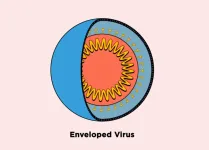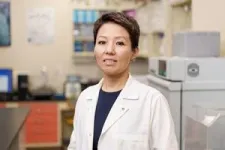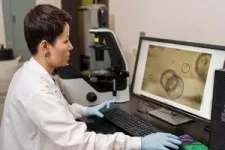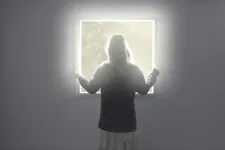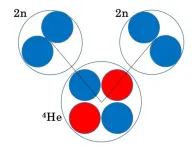(Press-News.org) Antiviral therapies are notoriously difficult to develop, as viruses can quickly mutate to become resistant to drugs. But what if a new generation of antivirals ignores the fast-mutating proteins on the surface of viruses and instead disrupts their protective layers?
“We found an Achilles heel of many viruses: their bubble-like membranes. Exploiting this vulnerability and disrupting the membrane is a promising mechanism of action for developing new antivirals,” said Kent Kirshenbaum, professor of chemistry at NYU and the study’s senior author.
In a new study published Aug. 2 in the journal ACS Infectious Diseases, the researchers show how a group of novel molecules inspired by our own immune system inactivates several viruses, including Zika and chikungunya. Their approach may not only lead to drugs that can be used against many viruses, but could also help overcome antiviral resistance.
The urgent need for new antivirals
Viruses have different proteins on their surfaces that are often the targets of therapeutics like monoclonal antibodies and vaccines. But targeting these proteins has limitations, as viruses can quickly evolve, changing the properties of the proteins and making treatments less effective. These limitations were on display when new SARS-CoV-2 variants emerged that evaded both the drugs and the vaccines developed against the original virus.
“There is an urgent need for antiviral agents that act in new ways to inactivate viruses,” said Kirshenbaum. “Ideally, new antivirals won’t be specific to one virus or protein, so they will be ready to treat new viruses that emerge without delay and will be able to overcome the development of resistance.”
“We need to develop this next generation of drugs now and have them on the shelves in order to be ready for the next pandemic threat—and there will be another one, for sure,” added Kirshenbaum.
Drawing inspiration from our immune systems
Our innate immune system combats pathogens by producing antimicrobial peptides, the body’s first line of defense against bacteria, fungi, and viruses. Most viruses that cause disease are encapsulated in membranes made of lipids, and antimicrobial peptides work by disrupting or even bursting these membranes.
While antimicrobial peptides can be synthesized in the lab, they are rarely used to treat infectious diseases in humans because they break down easily and can be toxic to healthy cells. Instead, scientists have developed synthetic materials called peptoids, which have similar chemical backbones to peptides but are better able to break through virus membranes and are less likely to degrade.
“We began to think about how to mimic natural peptides and create molecules with many of the same structural and functional features as peptides, but are composed of something that our bodies won't be able to rapidly degrade,” said Kirshenbaum.
The researchers investigated seven peptoids, many originally discovered in the lab of Annelise Barron at Stanford, a co-author of the study. The NYU team studied the antiviral effects of the peptoids against four viruses: three enveloped in membranes (Zika, Rift Valley fever, and chikungunya) and one without (coxsackievirus B3).
“We were particularly interested in studying these viruses as they have no available treatment options,” said Patrick Tate, a chemistry PhD student at NYU and the study’s first author.
How peptoids disrupt viral membranes and avoid other cells
The membranes surrounding viruses are made of different molecules than the virus itself, as lipids are acquired from the host to form membranes. One such lipid, phosphatidylserine, is present in the membrane on the outside of viruses, but is sequestered towards the interior of human cells under normal conditions.
“Because phosphatidylserine is found on the exterior of viruses, it can be a specific target for peptoids to recognize viruses, but not recognize—and therefore spare—our own cells,” said Tate. “Moreover, because viruses acquire lipids from the host rather than encoding from their own genomes, they have better potential to avoid antiviral resistance.”
The researchers tested seven peptoids against the four viruses. They found that the peptoids inactivated all three enveloped viruses—Zika, Rift Valley fever, and chikungunya—by disrupting the virus membrane, but did not disrupt coxsackievirus B3, the only virus without a membrane.
Moreover, chikungunya virus containing higher levels of phosphatidylserine in its membrane was more susceptible to the peptoids. In contrast, a membrane formed exclusively with a different lipid named phosphatidylcholine was not disrupted by the peptoids, suggesting that phosphatidylserine is crucial in order for peptoids to reduce viral activity.
“We’re now starting to understand how peptoids actually exert their antiviral effect—specifically, through the recognition of phosphatidylserine,” said Tate.
The researchers are continuing pre-clinical studies to evaluate the potential of these molecules in fighting viruses and to understand if they can overcome the development of resistance. Their peptoid-focused approach may hold promise for treating a wide range of viruses with membranes that can be difficult to treat, including Ebola, SARS-CoV-2, and herpes.
In addition to Kirshenbaum, Tate, and Barron, study authors include Vincent Mastrodomenico, Christina Cunha, and Bryan C. Mounce of Loyola University Chicago Medical Center; Joshua McClure of Maxwell Biosciences; and Gill Diamond of the University of Louisville School of Dentistry.
The research was supported in part by the National Science Foundation (CHE-2002890 and NSF GRFP) and the National Institutes of Health (R35GM138199 and 1DP1 OD029517-01). Kirshenbaum is the Chief Scientific Officer for Maxwell Biosciences, a biotech company that has licensed patents originating from his lab at NYU. The company is seeking to commercialize these compounds and bring them to the clinic to advance human health.
END
Novel molecules fight viruses by bursting their bubble-like membranes
Targeting the membrane of a virus, rather than its proteins, could lead to a new generation of antivirals
2023-08-02
ELSE PRESS RELEASES FROM THIS DATE:
More than 2,600 health care organizations recognized for commitment to high-quality cardiovascular care
2023-08-02
DALLAS, August 2, 2023 — The American Heart Association, a relentless force for a world of longer, healthier lives, has recognized 2,671 health care and emergency response organizations — nearly 145 more than in 2022 — for their commitment to improving health outcomes for cardiovascular patients through evidence-based efficient and coordinated care.
The American Heart Association’s Get With The Guidelines® and Mission: Lifeline® are hospital-based quality improvement recognition programs that use the latest evidence-based scientific guidelines to save lives and hasten health care recovery ...
Stalking a silent killer
2023-08-02
With a survival rate in the single digits, pancreatic ductal adenocarcinoma (PDAC) is highly lethal. In fact, by the time PDAC is clinically diagnosed, it is already considered incurable via surgery or other means in up to 90% of patients.
Yangzom D. Bhutia, D.V.M., Ph.D., from the Department of Cell Biology and Biochemistry at the Texas Tech University Health Sciences Center (TTUHSC) School of Medicine, has for years focused her research on PDAC. To bolster her efforts, the National Cancer Institute at the National Institutes of Health recently awarded Bhutia a five-year, $1.76 million grant (“SLC6A14 as a unique ...
Many people feel their jobs are pointless
2023-08-02
A sociological study by the University of Zurich confirms that a considerable proportion of employees perceive their work as socially useless. Employees in financial, sales and management occupations are more likely to conclude that their jobs are of little use to society.
In recent years, research showed that many professionals consider their work to be socially useless. Various explanations have been proposed for the phenomenon. The much-discussed “bullshit jobs theory” by the American anthropologist David Graeber, for example, states that some jobs are objectively useless and that this occurs more frequently ...
Abortion facility access means long drives for 41.8% of women
2023-08-02
SPOKANE, Wash. – One year after the Dobbs decision, 41.8% of U.S. women of reproductive age have to drive 30 minutes or more to reach an abortion care facility, according to a study of data as of June 2, 2023. Researchers predicted that number would rise to 53.5% if other state bills under consideration are passed.
The study estimated longer drives as well, finding that 29.3% of women didn’t have access to a facility within a 60-minute drive and 23.6% lacked access even within a 90-minute drive. Those figures would jump to 45.6% ...
Unhappy family or trauma in youth leads to poor health in old age
2023-08-02
Adverse childhood experiences have impacts deep into old age, especially for those who experienced violence, and include both physical and cognitive impairments.
It’s known that a difficult childhood can lead to a host of health issues as a young or midlife adult, but now, for the first time, researchers at UC San Franciso have linked adverse experiences early in life to lifelong health consequences.
They found that older U.S. adults with a history of stressful or traumatic experiences as children were more likely to experience both physical and cognitive impairments in their senior years. Stressful childhood experiences could include exposure to ...
Extroverts more likely to resist vaccines, study shows
2023-08-02
EL PASO, Texas (Aug. 2, 2023) – Which types of personalities were more hesitant about COVID-19 vaccination during the pandemic’s peak? Extroverts — according to a new study on more than 40,000 Canadians.
“We expected that people who were especially high in extroversion would be more likely to get the vaccine,” said Melissa Baker, Ph.D., lead author and assistant professor at The University of Texas at El Paso. “We figured those people would want to get back out in the world and socialize, right? It’s actually the opposite.”
The findings, ...
UTokyo researchers imagine future see-through objects
2023-08-02
Researchers from the Institute of Industrial Science(IIS), The University of Tokyo, conducts a wide range of research, including physics, chemistry and biology. In this context, DLX Design Lab carries out activities aimed at fusing science, technology, and design. One of these activities is the Treasure Hunting Project, which aims to inform the general public about the value and potential of scientific research. As part of this project, in 2022-2023, DLX Design Lab produced a video introducing future ...
Correlation between neutron pairs observed in helium-8 nuclei
2023-08-02
Atomic nuclei consist of nucleons such as protons and neutrons, which are bound together by nuclear force or strong interaction. This force allows protons and neutrons to form bound states; however, when only two neutrons are involved, the attractive force is slightly insufficient to create such a state. This prompts the question: would four neutrons be adequate? This question has captivated atom physicists, who have actively sought to unlock this mystery in both the theoretical and experimental realms.
With ...
Training on LSA lifeboat operation using Mixed Reality
2023-08-02
Research Background
The International Maritime Organization (IMO) has identified the human element as one of the key attributes for the safety of life at sea and a contributing factor to most of the casualties in the shipping sector. The International Convention for the Safety of Life at Sea (SOLAS) is an international maritime treaty which requires signatory flag states to ensure that ships flagged by them comply with minimum safety standards in construction, equipment and operation. As part of the SOLAS code, there is the requirement that all personnel on vessels at sea must undertake Standards of Training, ...
Humble feijoa to help prevent type 2 diabetes?
2023-08-02
Can the humble feijoa help the world tackle type 2 diabetes? University of Auckland scientists are investigating.
With more than 200,000 people in New Zealand living with type 2 diabetes, prevention is key to tackling this important health issue. Could a solution be found growing in New Zealand backyards?
The feijoa study, named FERDINAND, is a six-month weight-loss and maintenance programme, during which adults with raised blood sugar will be given about a gram of whole-fruit feijoa powder (or a placebo) each ...
LAST 30 PRESS RELEASES:
Injectable breast ‘implant’ offers alternative to traditional surgeries
Neuroscientists devise formulas to measure multilingualism
New prostate cancer trial seeks to reduce toxicity without sacrificing efficacy
Geometry shapes life
A CRISPR screen reveals many previously unrecognized genes required for brain development and a new neurodevelopmental disorder
Hot flush treatment has anti-breast cancer activity, study finds
Securing AI systems against growing cybersecurity threats
Longest observation of an active solar region
Why nail-biting, procrastination and other self-sabotaging behaviors are rooted in survival instincts
Regional variations in mechanical properties of porcine leptomeninges
Artificial empathy in therapy and healthcare: advancements in interpersonal interaction technologies
Why some brains switch gears more efficiently than others
UVA’s Jundong Li wins ICDM’S 2025 Tao Li Award for data mining, machine learning
UVA’s low-power, high-performance computer power player Mircea Stan earns National Academy of Inventors fellowship
Not playing by the rules: USU researcher explores filamentous algae dynamics in rivers
Do our body clocks influence our risk of dementia?
Anthropologists offer new evidence of bipedalism in long-debated fossil discovery
Safer receipt paper from wood
Dosage-sensitive genes suggest no whole-genome duplications in ancestral angiosperm
First ancient human herpesvirus genomes document their deep history with humans
Why Some Bacteria Survive Antibiotics and How to Stop Them - New study reveals that bacteria can survive antibiotic treatment through two fundamentally different “shutdown modes”
UCLA study links scar healing to dangerous placenta condition
CHANGE-seq-BE finds off-target changes in the genome from base editors
The Journal of Nuclear Medicine Ahead-of-Print Tip Sheet: January 2, 2026
Delayed or absent first dose of measles, mumps, and rubella vaccination
Trends in US preterm birth rates by household income and race and ethnicity
Study identifies potential biomarker linked to progression and brain inflammation in multiple sclerosis
Many mothers in Norway do not show up for postnatal check-ups
Researchers want to find out why quick clay is so unstable
Superradiant spins show teamwork at the quantum scale
[Press-News.org] Novel molecules fight viruses by bursting their bubble-like membranesTargeting the membrane of a virus, rather than its proteins, could lead to a new generation of antivirals
